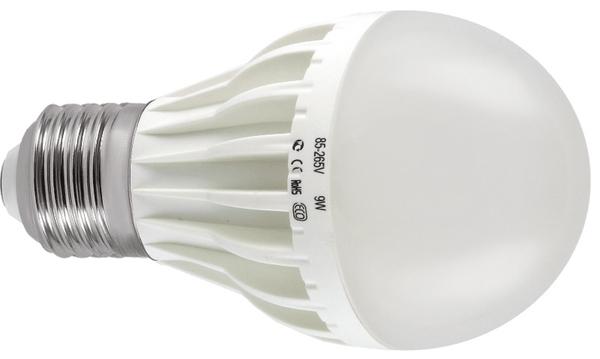1103
Is it worth it?
To replace incandescent and even energy saving lamps are gradually led model. Do I need to move on them now? Discuss this topic without advertising emotions and deep technical details, from the point of view of common sense.

The idea of switching to LED (in common parlance - "ice", the abbreviation LED, Light Emitting Diode) lamps for home use is slowly conquering the minds of consumers. The process, it should be noted, comes with a decent speed - the era of brutal price is over, the price gap LED- and energy saving lamps today reduced to an acceptable level. Maybe it's time?

About advantages of such lamps is written quite a lot. Why not just write LED-lamps in the pros: almost eternal work (up to 50 000 hours), and environmental and energy tends to zero ... not only coffee brewed.
Most interesting is that almost all of this is really true, but - with some reservations and the points. However, when listing the pros cons taken diligently to ignore that, unfortunately, there is even such superzamechatelnyh lamps.
For example, the service life. 50,000 hours - this is an ideal that is unattainable until now, at least, because no one can almost confirm whether or not a particular brand lamps and series producer today will burn continuously for almost six years without disconnecting.

Next - the color spectrum glow. Unfortunately, not all manufacturers can really give an honest "warm" light with a temperature of about 2700-3000K. As a result, you can buy as 6000 kelvinovyh unearthly monsters with dazzling white light with the departure into the blue, and light, giving a dull yellow light. Not warm, namely a bright yellow. This sin today, many Chinese manufacturers, but before that we have today, we reach.

As for the form factors and the overall appearance of the LED-lamps, they are available for all the most common cartridges: E27, E14, GU10 and MR16. Moreover, there are options and scattering light bulb, and just a "bare" LEDs on the top, and even unusual sight "lamp kukuruziny." There is already a matter of taste and application: if the lamp will be hidden decorative lampshades or just lining, suitable even simpler option open LEDs. Chandelier decent looks choice with flasks and reflectors.

Less lamp with a flat surface - not a wide angle scattered light generally not more than 120 degrees. They are usually designed for spot lighting (eg in the bathroom) to replace traditional halogen lamps. Lamp bulb with this shortcoming, mostly deprived, and it is understood even manufacturers simply "svetodiodok" that give now a new kind of traditional incandescent bulb. Which, incidentally, can not be said about the energy-saving lamps - they are compact fluorescent lamps (CFLs), which still look like ugly spiral.
Pros
Pros LED-lamps are numerous, significant and obvious. Firstly, low electricity consumption average power LED lamp - from 1 to 7 watts. Secondly, even the luminous flux and total power from the first moment (no need to wait a few minutes for the lamp to warm up, unlike many CFLs). Third, but not least, unlike CFLs, LED-lamps which are more environmentally friendly: if you drop and break a lamp to worry about toxic fumes hazardous chemicals, as in the case of an old lamp, do not have to.

When choosing LED-lamps also need to pay attention to the luminosity, expressed in lumens. Most lamps produce an average of no more than 250-400 lumens, enough except when illuminated a small room with no complaints on the quality of lighting every corner, for example, table lights or toilet (though in the latter case, less self-lovers in the cozy office) . On the old Russian cuisine is also still be seen antediluvian fixtures on one horn: Down with them! If the chandelier in 3-6 horns, this question can be safely ignored.

In terms of reliability, alas, all the while situation is much the same as with energy-saving lamps: in the tens of thousands of hours of theory, but in practice everything depends on krivorukost build on the quality of the original components and the amount of integrity producer. In other words, have to check in practice.
Do not be surprised if some light will live a long time, and the other from the same party fails after a few weeks. Therefore, it is at the forefront with such lamps and is notorious guarantee: when buying a watch that the free replacement warranty for a failed lamp was at least a year. Even better - three or more, but this is for the serious brands like OSRAM or Philips.

Summing up, it can be summarized as follows. Of course, even now switching to LED bulbs already economically viable, the cost is more or less acceptable, and the balance of the "price / quality", as usual, everyone decides for himself. However, the final, more or less reliable statistics on the reliability of LED lamps from different manufacturers will have to wait for more.


The idea of switching to LED (in common parlance - "ice", the abbreviation LED, Light Emitting Diode) lamps for home use is slowly conquering the minds of consumers. The process, it should be noted, comes with a decent speed - the era of brutal price is over, the price gap LED- and energy saving lamps today reduced to an acceptable level. Maybe it's time?

About advantages of such lamps is written quite a lot. Why not just write LED-lamps in the pros: almost eternal work (up to 50 000 hours), and environmental and energy tends to zero ... not only coffee brewed.
Most interesting is that almost all of this is really true, but - with some reservations and the points. However, when listing the pros cons taken diligently to ignore that, unfortunately, there is even such superzamechatelnyh lamps.
For example, the service life. 50,000 hours - this is an ideal that is unattainable until now, at least, because no one can almost confirm whether or not a particular brand lamps and series producer today will burn continuously for almost six years without disconnecting.

Next - the color spectrum glow. Unfortunately, not all manufacturers can really give an honest "warm" light with a temperature of about 2700-3000K. As a result, you can buy as 6000 kelvinovyh unearthly monsters with dazzling white light with the departure into the blue, and light, giving a dull yellow light. Not warm, namely a bright yellow. This sin today, many Chinese manufacturers, but before that we have today, we reach.

As for the form factors and the overall appearance of the LED-lamps, they are available for all the most common cartridges: E27, E14, GU10 and MR16. Moreover, there are options and scattering light bulb, and just a "bare" LEDs on the top, and even unusual sight "lamp kukuruziny." There is already a matter of taste and application: if the lamp will be hidden decorative lampshades or just lining, suitable even simpler option open LEDs. Chandelier decent looks choice with flasks and reflectors.

Less lamp with a flat surface - not a wide angle scattered light generally not more than 120 degrees. They are usually designed for spot lighting (eg in the bathroom) to replace traditional halogen lamps. Lamp bulb with this shortcoming, mostly deprived, and it is understood even manufacturers simply "svetodiodok" that give now a new kind of traditional incandescent bulb. Which, incidentally, can not be said about the energy-saving lamps - they are compact fluorescent lamps (CFLs), which still look like ugly spiral.
Pros
Pros LED-lamps are numerous, significant and obvious. Firstly, low electricity consumption average power LED lamp - from 1 to 7 watts. Secondly, even the luminous flux and total power from the first moment (no need to wait a few minutes for the lamp to warm up, unlike many CFLs). Third, but not least, unlike CFLs, LED-lamps which are more environmentally friendly: if you drop and break a lamp to worry about toxic fumes hazardous chemicals, as in the case of an old lamp, do not have to.

When choosing LED-lamps also need to pay attention to the luminosity, expressed in lumens. Most lamps produce an average of no more than 250-400 lumens, enough except when illuminated a small room with no complaints on the quality of lighting every corner, for example, table lights or toilet (though in the latter case, less self-lovers in the cozy office) . On the old Russian cuisine is also still be seen antediluvian fixtures on one horn: Down with them! If the chandelier in 3-6 horns, this question can be safely ignored.

In terms of reliability, alas, all the while situation is much the same as with energy-saving lamps: in the tens of thousands of hours of theory, but in practice everything depends on krivorukost build on the quality of the original components and the amount of integrity producer. In other words, have to check in practice.
Do not be surprised if some light will live a long time, and the other from the same party fails after a few weeks. Therefore, it is at the forefront with such lamps and is notorious guarantee: when buying a watch that the free replacement warranty for a failed lamp was at least a year. Even better - three or more, but this is for the serious brands like OSRAM or Philips.

Summing up, it can be summarized as follows. Of course, even now switching to LED bulbs already economically viable, the cost is more or less acceptable, and the balance of the "price / quality", as usual, everyone decides for himself. However, the final, more or less reliable statistics on the reliability of LED lamps from different manufacturers will have to wait for more.

20 archival photographs Wall Street comes from the XX century
These 35 pictures inspire your uncontrolled fits of laughter
























